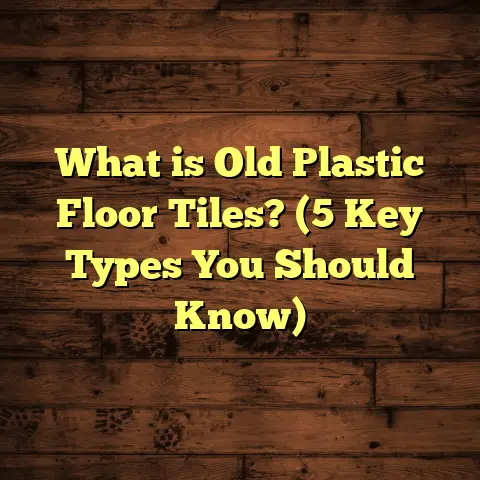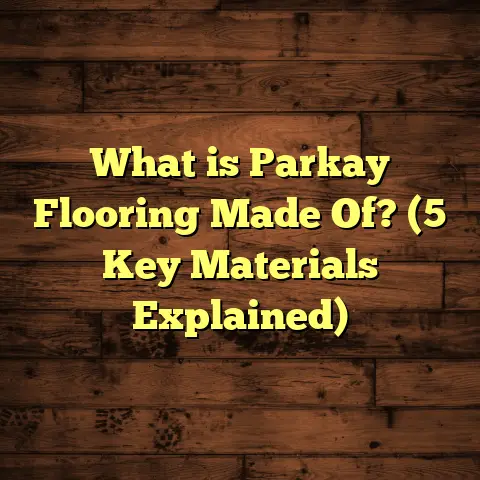What is Cheaper: Flooring or Carpet? (5 Cost-Effective Options)
Craftsmanship is something I’ve come to deeply appreciate over years of working in flooring. There’s a certain magic in transforming a bare, cold subfloor into a warm, inviting space that invites people to kick off their shoes and relax. Whether it’s the smooth finish of hardwood, the gentle cushion of carpet, or the sleek durability of tile, the floor beneath our feet sets the tone for a room’s comfort and style. But beyond aesthetics and feel, one question I hear all the time is about cost. Specifically: what’s cheaper, flooring or carpet? And to dig into that, we have to look at different types of flooring materials and carpet options, their installation costs, maintenance, lifespan, and overall value.
I want to take you through everything I’ve learned from hands-on experience, backed by numbers and real projects. I’ll share stories, data points, and insights that can help you decide which flooring makes the most sense for your budget and lifestyle. Let’s jump right in.
What is Cheaper: Flooring or Carpet?
To answer this question, we first need to define what we mean by “flooring.” Usually, when people say flooring, they mean hard surface floors like hardwood, laminate, vinyl, tile, or engineered wood. Carpet is a soft floor covering made of woven or tufted fibers.
Both carpet and hard flooring have their own cost structures. The price you pay includes the material cost, installation labor, and ongoing maintenance. Plus, the lifespan of each material affects how often you’ll need to replace it — impacting your long-term expenses.
From my years installing and repairing floors in homes and commercial spaces, I can say there’s no one-size-fits-all answer. It depends on your priorities and situation. But I’m going to compare five popular and cost-effective options in detail: carpet, vinyl, laminate, engineered hardwood, and ceramic tile.
I’ll break down their costs with examples from real jobs I’ve done and data from industry sources. Along the way, I’ll share tips to help you avoid unexpected expenses.
1. Carpet — The Affordable Comfort Option
Carpet is often seen as the budget-friendly choice. I’ve installed carpet in everything from rental apartments to family homes.
Material Costs: Basic synthetic carpets range from $1 to $3 per square foot. Mid-grade nylon carpets usually fall between $2 and $5 per square foot. Higher-end wool or specialty carpets can cost $7 or more per square foot.
Installation Costs: Installing carpet typically costs $0.50 to $2 per square foot depending on the complexity of the job. Simple rooms with square layouts are cheaper; stairs and rooms with odd shapes increase labor.
Total Cost Range: Generally, you can expect $1.50 to $7 per square foot all-in.
My Experience with Carpet
One project stands out vividly in my mind. I installed carpet in a 1,000 sq ft family room for a young couple upgrading from an old rental. They chose mid-range nylon carpet at about $3 per sq ft. Including installation, we were just under $5 per sq ft total — around $5,000.
The room instantly felt cozy and warm. The kids loved running barefoot on it. But after about 7 years with heavy use and some spills, the carpet showed noticeable wear and stains that even professional cleaning couldn’t fix.
I recommended replacing it then rather than trying to salvage it again. That cycle of replacement every 7-10 years is typical for carpet in busy homes.
Maintenance Costs
Carpet requires frequent vacuuming and occasional deep cleaning. Professional cleaning every 12-18 months costs about $0.25 per square foot on average but helps extend carpet life.
If you skip maintenance, you reduce lifespan drastically.
Pros and Cons of Carpet for Cost
| Pros | Cons |
|---|---|
| Lowest initial outlay | Shorter lifespan (5-10 years) |
| Soft underfoot; noise reduction | Requires regular cleaning |
| Easy installation | Can retain stains and allergens |
2. Vinyl Flooring — Durable and Budget-Friendly
Vinyl is a versatile option that has gained popularity due to its water resistance and low cost.
Material Costs: Vinyl sheets or planks typically cost between $2 and $5 per square foot depending on quality and design.
Installation Costs: Labor usually runs from $1 to $3 per square foot because vinyl is relatively easy to install but requires careful subfloor prep.
Total Cost Range: Around $3 to $8 per square foot.
My Vinyl Story
I installed vinyl flooring in a 500 sq ft kitchen remodel where water resistance was essential. We used mid-grade luxury vinyl planks costing about $3 per sq ft plus $2 per sq ft for installation.
The total was just under $2,500 — a reasonable price for a durable surface that held up well against spills and heavy foot traffic.
The homeowners appreciated how easy it was to clean compared to their old linoleum floor.
Maintenance Notes
Vinyl floors need simple cleaning with mild soap and water. Avoid abrasive cleaners that can dull the finish.
Pros & Cons of Vinyl Flooring
| Pros | Cons |
|---|---|
| Affordable upfront | Can dent or scratch under heavy impact |
| Water-resistant | May fade over time with sun exposure |
| Easy maintenance | Some lower-quality products feel cheap |
3. Laminate Flooring — Wood Look Without the Price
Laminate imitates hardwood look using photographic layers over MDF or HDF boards.
Material Costs: Laminate boards usually cost between $1.50 and $4 per square foot.
Installation Costs: Installation is more labor-intensive than vinyl due to precise fittings; expect $2 to $4 per square foot labor.
Total Cost Range: $3.50 to $8 per square foot including installation.
My Take on Laminate
A client who loved hardwood aesthetics but had a tight budget opted for laminate in their 1,000 sq ft living area. We used textured oak-look laminate costing $2 per sq ft plus installation around $3 per sq ft.
Total project came to just under $5,000 — a great compromise for style on a budget.
Over five years, the floor stayed looking good with basic care but did swell slightly near an exterior door where moisture seeped in — something solid wood handles better.
Maintenance
Laminate is easy to clean with dry mopping or damp cloths but avoid standing water which damages boards.
Pros & Cons of Laminate Flooring
| Pros | Cons |
|---|---|
| Affordable wood look | Vulnerable to moisture damage |
| Durable surface layer | Can chip or scratch |
| Easy DIY installation | Not refinishable |
4. Engineered Hardwood — Balancing Cost & Elegance
Engineered hardwood has a top layer of real wood over plywood layers for stability.
Material Costs: Usually between $3 and $7 per square foot depending on wood species and thickness.
Installation Costs: Labor ranges from $3 to $6 per square foot due to specialized fitting techniques.
Total Cost Range: Around $6 to $13 per square foot installed.
My Experience with Engineered Hardwood
For a client renovating a 800 sq ft living room with fluctuating temperatures, engineered hardwood was perfect — more stable than solid wood but still authentic in appearance.
We spent about $7,000 total using mid-grade oak veneer boards with professional installation.
The floor still looks stunning after 8 years with minor refinishing needed once during that time frame.
Maintenance Insights
Engineered hardwood requires periodic refinishing every 10-15 years unlike laminate or vinyl but is more resistant to warping than solid wood in humid climates.
Pros & Cons of Engineered Hardwood
| Pros | Cons |
|---|---|
| Looks like real wood | Higher upfront cost |
| More stable than solid wood | Requires refinishing occasionally |
| Adds resale value | Sensitive to moisture |
5. Ceramic Tile — Durable but Can Be Pricey
Ceramic tile offers durability and design flexibility but varies widely in price based on style and size.
Material Costs: From as low as $1 per sq ft for basic tiles up to $15+ for designer styles.
Installation Costs: Labor is costly due to precision cutting and grouting — typically between $5 and $10 per sq ft.
Total Cost Range: Roughly $6 to $25+ per sq ft installed.
Tile Installation Story
I helped a homeowner redo their bathroom (350 sq ft) using mid-grade ceramic tiles costing about $4 per sq ft plus about $7 per sq ft installation labor.
The total was close to $2,500 but worth it given tile’s durability in wet areas.
The floor remains beautiful after several years with minimal maintenance besides regular cleaning of grout lines.
Maintenance Tips
Sealing grout lines prevents stains and mold buildup. Tiles themselves are low-maintenance but grout needs care.
Pros & Cons of Ceramic Tile
| Pros | Cons |
|---|---|
| Very durable | High installation cost |
| Water-resistant | Cold underfoot |
| Wide design options | Can crack if subfloor shifts |
How Do These Options Compare Long Term?
It’s crucial to consider not just initial costs but lifespan and maintenance too. Here’s what typical lifespans look like:
- Carpet: 5-10 years
- Vinyl: 10-20 years
- Laminate: 10-20 years
- Engineered hardwood: 15-20 years
- Ceramic tile: 20+ years
Using these numbers, I calculated average yearly costs by dividing total installed price by expected lifespan:
| Type | Installed Cost ($/sq ft) | Lifespan (years) | Cost Per Year ($/sq ft) |
|---|---|---|---|
| Carpet | 1.50 – 7 | 5 – 10 | 0.15 – 1.40 |
| Vinyl | 3 – 8 | 10 – 20 | 0.15 – 0.80 |
| Laminate | 3.50 – 8 | 10 – 20 | 0.18 – 0.80 |
| Engineered Hardwood | 6 – 13 | 15 – 20 | 0.30 – 0.87 |
| Ceramic Tile | 6 – 25+ | 20+ | 0.30 – 1.25+ |
This table shows why carpet may seem cheapest at first glance but can add up due to shorter lifespan and replacement cycles.
Waste Factors & Installation Complexities
When planning budgets, don’t overlook waste during installation:
- Carpet waste factor: about 5-10% due to fitting around corners.
- Hard flooring waste: around 10-15% because of cuts and breakage.
Tile installation demands more skill than carpet or vinyl which raises labor costs significantly.
Personal Tips Based on My Experience
- Use carpet in low-traffic areas or bedrooms where comfort matters most.
- Choose vinyl or laminate for kitchens or kids’ playrooms where durability plus budget is key.
- Invest in engineered hardwood or tile for main living spaces if you want long-term value.
- Mix flooring types strategically — it cuts costs while maximizing comfort.
- Don’t skimp on installation quality; poor work can shorten floor life no matter the material.
- Factor in maintenance when comparing costs; some floors need more upkeep than others.
Real-Life Case Study: Budgeting for a Complete Floor Overhaul
A family I worked with wanted new floors throughout their 1,500 sq ft home but had a limited budget around $12,000 total including materials and labor.
We broke down costs like this:
- Carpet (bedrooms): mid-grade nylon at $4/sq ft installed → approx. $4,500 for ~1,125 sq ft
- Vinyl plank (kitchen/dining): at $5/sq ft → approx. $1,875 for ~375 sq ft
- Total project cost: ~$6,375 — well under budget allowing for trim work and floor prep
This combination balanced upfront savings with durability where needed most while keeping bedrooms cozy with carpet underfoot.
Final Thoughts
If you want the lowest upfront expense with comfort in mind, carpet beats out hard flooring hands down — especially if you’re okay replacing it every decade or so.
For better durability without breaking the bank, vinyl or laminate are excellent choices offering good looks at reasonable prices.
If you want floors that boost home value and last decades with proper care, engineered hardwood or ceramic tile are worth investing in despite higher initial costs.
Choosing between flooring types comes down to your lifestyle needs, budget constraints, maintenance willingness, and how long you plan on staying in your home.
Have you thought about mixing carpet with hard surfaces? I find many clients prefer this combo—carpet in bedrooms for softness; hard floors in kitchens or hallways for easy cleaning and durability.
Need help crunching numbers specific to your space? Feel free to share your project details—I can help create realistic estimates tailored just for you!





